

Global high-mix volume high-speed PCBA manufacturer
9:00 -18:00, Mon. - Fri. (GMT+8)
9:00 -12:00, Sat. (GMT+8)
(Except Chinese public holidays)


Global high-mix volume high-speed PCBA manufacturer
9:00 -18:00, Mon. - Fri. (GMT+8)
9:00 -12:00, Sat. (GMT+8)
(Except Chinese public holidays)
HomePage > Blog > Knowledge Base > Microcontroller vs. Microprocessor: Key Differences and Selection Guide
In electronic design and embedded system development, it is very important to understand the difference between microprocessors and microcontrollers. These two terms appear frequently, but many people tend to confuse their meanings. Although they both serve as the brains of electronic devices, they differ greatly in structure, function, speed and application.
The microprocessor is like a general-purpose brain. It is suitable for handling complex tasks, such as running operating systems and large programs. The microcontroller is more like a multifunctional manager. It integrates the CPU, memory and interfaces all on a single chip, making it more suitable for specific and simple control tasks, such as controlling household appliances or sensors.
Whether you are a beginner or working on IoT, smart hardware or consumer electronics projects, understanding the differences between microcontrollers and microprocessors can help you choose the right solution, control costs, and improve efficiency. This article will explain microprocessors and microcontrollers in detail from aspects such as structure, function, performance and application to help you make wise choices.
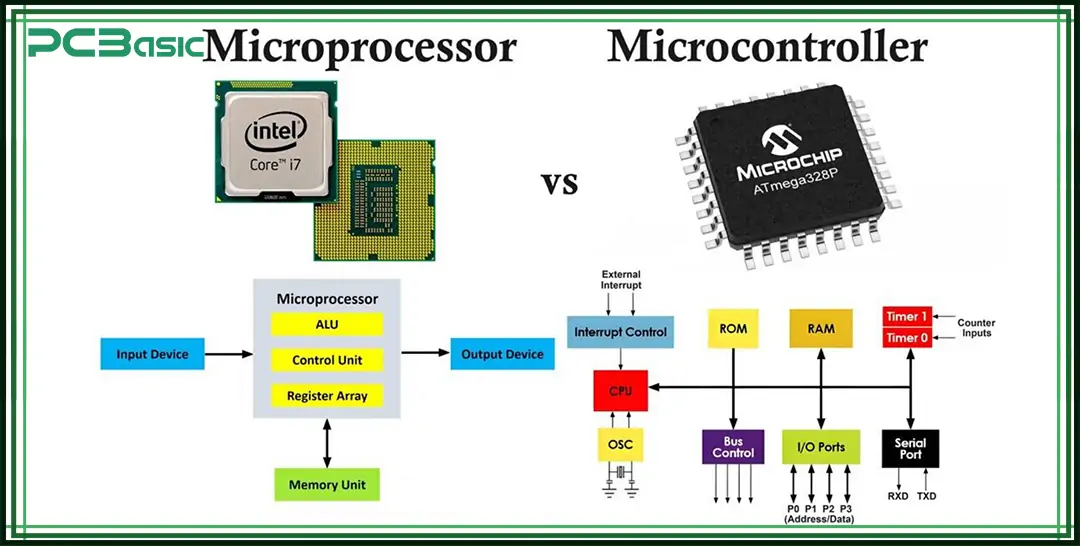
A microprocessor is a general-purpose central processing unit (CPU) integrated on a single chip dedicated to high-speed data processing and complex computing. Unlike microcontrollers, microprocessors themselves do not contain built-in memory or input/output interfaces. They rely on external RAM, ROM and I/O modules to achieve complete system functions. It is often regarded as the brain of a computer, possessing powerful computing capabilities. However, it requires the collaborative work of other external components.
Typical microprocessors include Intel Core i7/i9, AMD Ryzen, ARM Cortex-A (widely used in smartphones), and Broadcom BCM2711 (for Raspberry PI). This type of chip typically has a relatively high clock frequency (measured in GHz) and is suitable for application scenarios that require multitasking, graphics rendering, or complex system management.
When discussing microcontroller vs. microprocessor, microprocessors are more suitable for application in general computing devices, such as desktop computers, servers, and high-performance embedded systems, rather than in low-power or resource-constrained scenarios.
According to different application requirements, microprocessors can be classified into the following types, and each one has its own specific scenarios and advantages:
This type of microprocessor supports the execution of complex instructions, and each instruction can complete multiple operations, thereby reducing the number of code lines in a program. A typical representative is Intel's x86 architecture, which is widely used in personal computers and servers.
They adopt simple and fixed-length instructions, with a faster execution speed for each instruction, making them suitable for efficient computing. The ARM Cortex-A series processors are the common RISC architecture and are often used in smartphones and tablet computers.
This type of microprocessor is specifically designed to process real-time signals, such as audio, video and radar. DSP is good at performing repetitive mathematical calculations and is widely used in the fields of communication, audio processing and image recognition.
GPUs are designed for the parallel processing of large amounts of image and video data, accelerating the speed of image rendering. They are commonly seen in graphics-intensive tasks such as games, 3D modeling and deep learning. The representative products include the NVIDIA RTX series.
ASICs are microprocessors customized for specific tasks. They are not universal but highly efficient in the target application. For instance, ASIC chips used for cryptocurrency mining perform exceptionally well in terms of computing efficiency and energy consumption control.
It is dedicated to the input and output functions of the management system and operates separately from the main CPU. It reduces the burden on the main processor and improves the response speed and efficiency of the overall system.
Understanding the types of these microprocessors helps to select the appropriate microprocessor based on the specific project requirements, thereby achieving a balance between performance, cost and power consumption.
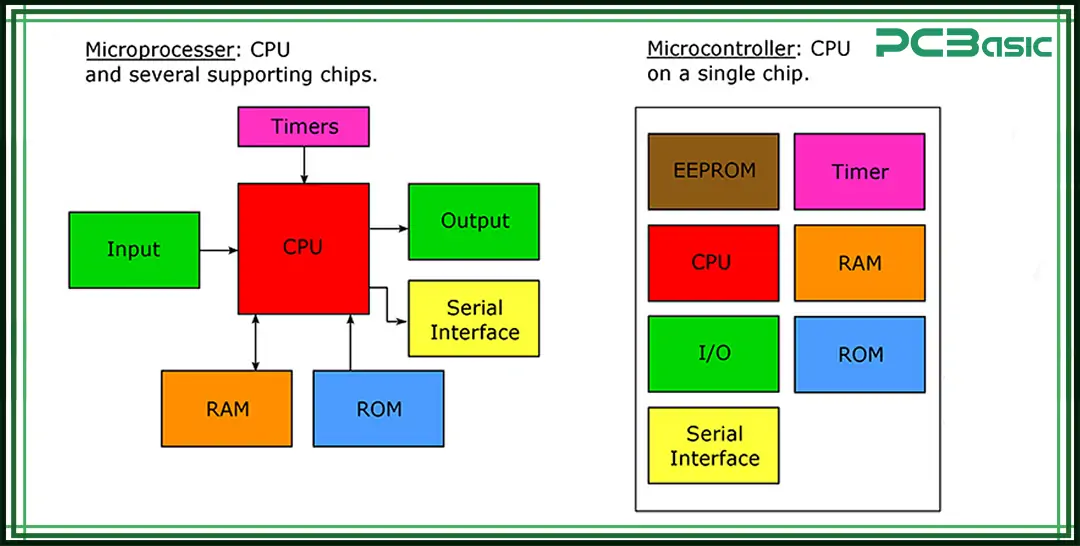
A microcontroller is a highly integrated chip that contains a central processing unit (CPU), memory (RAM and ROM), and various commonly used peripherals, such as timers, analog-to-digital converters (ADCs) and input/output ports (I/O). It is like a small computer. All functions are integrated into a single chip and can independently complete specific control tasks without relying on external components. Compared to microprocessors that require a large number of peripheral devices for support, microcontrollers have obvious advantages in terms of size, cost and power consumption.
So, what are microcontrollers used for? Microcontrollers are widely used in various embedded systems, especially those devices that are compact in structure, have limited resources, and require stable operation. For instance, in household appliances such as washing machines, thermostats, and air purifiers; in industrial control, sensor modules and actuators; in medical devices like blood pressure monitors and heart rate monitors; as well as in smart homes, lighting control systems, door locks, and remote control devices.
Common microcontroller models include the ATmega328P (widely used in Arduino Uno), STM32 series, PIC16F877A, and ARM Cortex-M series. The clock frequencies of these devices range from tens to hundreds of MHz, which is much lower than that of microprocessors at the GHz level. However, this also brings a significant low-power consumption advantage, making them highly suitable for low-power applications that operate for long periods.
When discussing the difference between a microcontroller and a microprocessor, the greatest advantage of the microcontroller lies in integrating all the resources required for control within a single chip. It is suitable for occasions where the control tasks are clear, and there are high requirements for cost and power consumption, while microprocessors are more suitable for handling complex operations and general computing tasks. Understanding these differences is helpful for developers to make reasonable selections between microcontrollers and microprocessors based on project requirements.
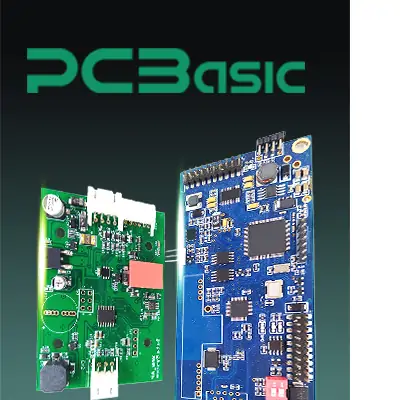 About PCBasic
About PCBasic
Time is money in your projects – and PCBasic gets it. PCBasic is a PCB assembly company that delivers fast, flawless results every time. Our comprehensive PCB assembly services include expert engineering support at every step, ensuring top quality in every board. As a leading PCB assembly manufacturer, we provide a one-stop solution that streamlines your supply chain. Partner with our advanced PCB prototype factory for quick turnarounds and superior results you can trust.
Based on architecture, performance, and integration level, microcontrollers can be classified into several categories. Understanding these types helps in evaluating the best choice between microprocessors and microcontrollers for your project.
• 8-bit microcontrollers: These MCUs can process 8 bits of data at a time. They are suitable for simple control tasks like switch control, LED driving, or keyboard scanning. A common example is the ATmega328P, widely used in beginner platforms like Arduino.
• 16-bit microcontrollers: These offer better processing capability than 8-bit MCUs and are suitable for moderately complex tasks. They are often used in industrial control and measurement systems. A typical example is the TI MSP430 series.
• 32-bit microcontrollers: These support more complex operations and have more peripheral interfaces. Their performance is close to that of lightweight processors, making them suitable for advanced applications like automation and smart devices. Common models include ARM Cortex-M3, M4, and M7.
• Embedded memory microcontrollers: These have RAM, ROM, Flash, and I/O integrated into one chip. They are true “system-on-chip” (SoC) designs, ideal for low-cost, low-power, and space-constrained embedded systems.
• External memory microcontrollers: These require external chips for some memory functions, such as program storage or data buffering. They are used in applications that demand large program size or memory, such as data acquisition or multimedia processing.
• RISC-based microcontrollers: These use a reduced instruction set, which allows faster execution and lower power consumption. They are widely used in portable devices and general embedded systems.
• FPGA microcontrollers: These combine programmable logic with control functions, allowing users to customize hardware behavior. They are suitable for high-performance, custom applications like industrial automation or image processing.
• ARM microcontrollers: Based on ARM Cortex-M cores, these are among the most popular microcontrollers today. They are used in consumer electronics, automotive systems, and IoT devices. ARM MCUs offer a great balance between performance and power efficiency and benefit from a mature development ecosystem.
These microcontroller types cover a wide range of use cases, from basic control functions to complex embedded systems. They form a key part of understanding the real-world differences between a microprocessor and a microcontroller, helping engineers make the right hardware choice.
The core of the difference between a microprocessor and a microcontroller lies in their architectures:
|
Feature |
Microprocessor |
Microcontroller |
|
Memory |
External RAM and ROM |
Built-in RAM and ROM |
|
Peripherals |
Needs external I/O |
On-chip I/O (UART, SPI, I2C, GPIO) |
|
Bus System |
External data and address buses |
Internal control bus |
|
Architecture |
Von Neumann |
Harvard |
|
Component Count |
CPU-only |
CPU + Memory + I/O |
|
Instruction Execution |
Sequential |
Parallel via internal modules |
We can learn from the table that the main difference between microcontroller and microprocessor lies in the different degrees of system integration. A microcontroller is a completely independent system. The chip already includes a CPU, memory and peripheral interfaces and can directly run tasks. A microprocessor, on the other hand, is merely a CPU and requires external memory, storage and I/O modules to form a complete system. In simple terms, one is a complete set, and the other is core necessary accessories.
Performance and power consumption are two key factors when choosing between a microcontroller or microprocessor (microcontroller and microprocessor).
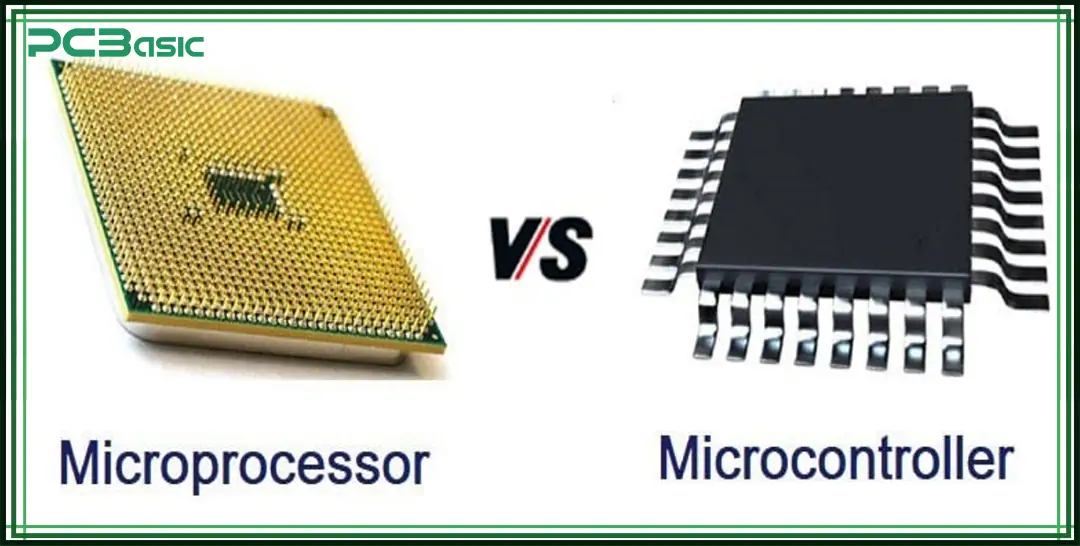
In terms of performance, a microprocessor is designed for speed and multitasking. It usually runs at high clock speeds (3–4 GHz), supports floating-point operations, has large cache memory, and handles complex instructions. This makes it suitable for tasks like image processing, data analysis, or running desktop-level operating systems.
On the other hand, a microcontroller focuses on energy efficiency and control tasks. While it operates at lower speeds (usually under 200 MHz), it includes built-in low-power features like sleep modes, power gating, and the ability to shut down unused modules. These features are ideal for battery-powered devices, long-term operation, and embedded applications such as sensors, home appliances, or wearables.
So, if your project needs high-speed computing and handles complex tasks, a microprocessor is a better fit. But if your priority is low power usage, fast real-time response, and low cost, then a microcontroller is the better choice. Understanding this trade-off is essential when comparing microcontrollers vs microprocessors in any design.
When making the decision between microcontrollers and microprocessors, we need to consider the following factors:
|
Decision Factor |
Microcontroller |
Microprocessor |
|
Task Complexity |
Ideal for simple, fixed, and repetitive control tasks |
Best suited for multitasking, complex operations, and high data processing |
|
Power Supply |
Low-power design, supports battery operation, sleep modes |
Higher power consumption requires a constant and stable power supply |
|
Size & Cost |
Single-chip solution, compact and cost-effective |
Requires multiple external modules, more complex and expensive |
|
Real-Time Control |
Fast response, suitable for real-time control applications |
Generally not ideal for strict real-time tasks |
|
Typical Applications |
Home appliances, sensors, industrial control, automotive electronics, wearables |
Computers, smartphones, servers, AI systems, graphics platforms |
This chart clearly illustrates the difference between microprocessors and microcontrollers in real-world applications and helps engineers make informed architectural choices.
Understanding the difference between microprocessors and microcontrollers is essential for designing efficient electronic systems. A microprocessor offers higher computing power and faster processing, making it ideal for devices that run complex software or perform multitasking operations. In contrast, a microcontroller is optimized for low power consumption, compact size, and high integration, making it perfect for control-focused embedded applications.
To summarize:
• Choose a microprocessor when your project requires running an operating system, handling a graphical interface, or processing large amounts of data.
• Choose a microcontroller for low-power, compact devices focused on specific control tasks.
Whether you're developing an industrial automation system, a wearable device, or a high-performance server, selecting the right microcontroller or microprocessor will have a direct impact on your system's architecture, cost, and efficiency.
Q1: What is the main difference between a microprocessor and a microcontroller?
A1: A microprocessor contains only the CPU and relies on external memory and peripherals. A microcontroller integrates CPU, memory, and I/O on a single chip.
Q2: Which is better – microcontroller or microprocessor?
A2: It depends. Use a microcontroller for control-based applications and a microprocessor for complex, general-purpose computing.
Q3: Can microcontrollers run an operating system?
A3: Some advanced microcontrollers can run lightweight real-time operating systems (RTOS), but they usually run bare-metal code.
Q4: Is Raspberry Pi a microcontroller or microprocessor?
A4: Raspberry Pi uses a microprocessor (Broadcom ARM Cortex-A), but Raspberry Pi Pico is a microcontroller board.
Q5: Are microprocessors faster than microcontrollers?
A5: Yes, microprocessors typically operate at higher clock speeds and support more complex operations.
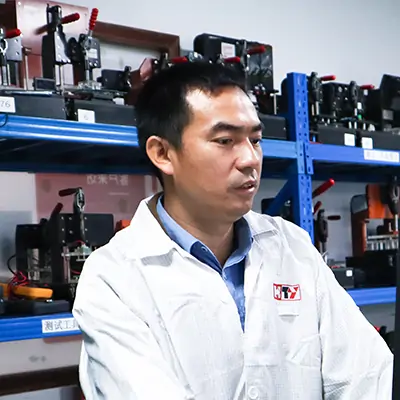
Assembly Enquiry
Instant Quote
Phone contact

+86-755-27218592
In addition, we've prepared a Help Center. We recommend checking it before reaching out, as your question and its answer may already be clearly explained there.
Wechat Support

In addition, we've prepared a Help Center. We recommend checking it before reaching out, as your question and its answer may already be clearly explained there.
WhatsApp Support

In addition, we've prepared a Help Center. We recommend checking it before reaching out, as your question and its answer may already be clearly explained there.
